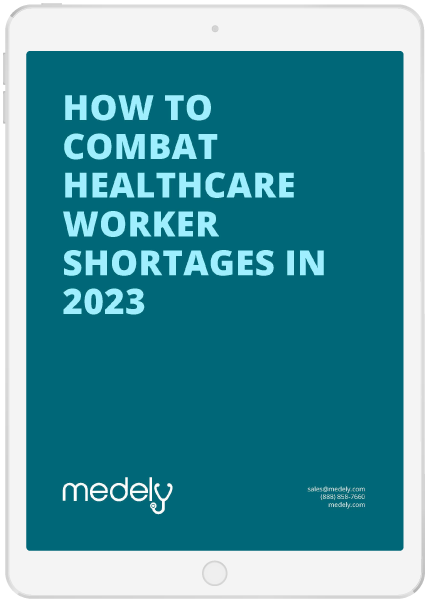Staffing in hospitals and other healthcare facilities, like post-acute care and surgery centers, is one of the most critical priorities for administrators. Ensuring enough nurses, support staff, and other allied healthcare professionals on each shift is essential to patient care. However, having adequate healthcare staff has become more challenging in recent years and the impact of staffing shortages on patient care continues to be a struggle for facilities.
Experts have been predicting a nursing shortage for many years. As early as 2015, analysts noted that nurses were leaving the profession more quickly than they could be replaced. Much of this attrition is the natural result of nurses reaching retirement age; as of 2022, there were around one million registered nurses over 50. As many as 80,000 nurses per year may retire between now and 2030. This change in the healthcare hiring environment could significantly affect healthcare delivery.
Healthcare facilities need to be thinking proactively about ensuring that they have adequate nursing staff. Having enough nurses available to meet all patient needs within the hospital is critical. Consistent staffing shortages have troubling consequences for patient health outcomes. In addition, nurses report negative feelings about being overworked and overwhelmed.
The results of understaffing can have a wide array of effects on your facility, patients, and staff.
Negative Clinical Outcomes
Nurses and allied healthcare staff provide a significant portion of the care for individuals in an inpatient setting. Nurses administer medication, provide wound care, monitor vital signs, and offer valuable observations on a patient’s condition. Often, nurses can be the first to identify a complication and alert doctors that a patient requires additional care.
Adding patients to a nurse’s roster means they must divide their time and attention between more beds. This can lead to poor clinical outcomes for patients. One Journal of Nursing Administration study found that “the lower the proportion of professional nursing staff employed on a unit, the higher the number of medication errors and wound infections.”
Some research indicates that increased numbers of registered nurses working in healthcare facilities can reduce the readmission rate for specific patient types, such as nursing home residents. Another New England Journal of Medicine study showed that nursing staffing levels that fell below target levels were associated with increased mortality.

How to Combat Healthcare Worker Shortages in 2023
Learn how to combat healthcare worker shortages with an extended workforce to maintain continuity of care and gain access to tools you can use to manage your extended workforce more effectively and efficiently. In this eBook, you’ll learn:
- ■ Why nurses are leaving full-time jobs behind.
- ■ The factors impacting healthcare professional employment.
- ■ How you can use an extended workforce to meet demand.
- ■ How you can use data-led staffing planning to manage costs.
Missed Care
Inadequate staffing levels can lead to sub-clinical errors in care. An article published in 2018 showed that lower staffing levels led to missed care. Nurses reported missing medication doses, delaying wound care, limited capacity to conduct adequate patient surveillance, and communication failures with patients and their families.
The study found that missed care was common: 75 percent or more nurses reported omitting some care. Multiple studies cited in the article found low nurse staffing levels were significantly associated with higher reports of missed care.
Poor Patient Experience
Even if patients are discharged without complications or errors, they may leave the hospital feeling like a staff shortage compromised their care. Lack of nursing care and attention from nurses can lead to general patient dissatisfaction with their length of stay and the quality of nurse-delivered care.
Patients may feel that their needs were not met during their stay. They may also think that they don’t have adequate aftercare instructions at discharge. This can cause confusion or errors during their recovery process at home.
Negative patient experiences can have repercussions for facilities, as well. For instance, people may share their experiences with others in the community. This can deter potential patients from seeking treatment at hospitals where they fear they won’t receive adequate care.
Staff Burnout
Nursing has always been a high-stress career, particularly for nurses working in hospitals. Long shifts, erratic schedules, and the burden of paperwork on top of patient care have always led to stress and fatigue for nurses and other healthcare support staff.
When facilities are understaffed, the remaining workforce has to take on additional duties. This often means extra effort and work without additional time to accomplish it. For staff involved in direct patient care, this can be high-stakes work with life-and-death results.
Overwork can lead to burnout. That, in turn, may exacerbate staffing issues if nurses resign due to overly stressful working conditions. A JAMA study from 2021 showed burnout is a significant cause of job dissatisfaction among nurses and a leading reason why nurses leave their jobs.
Denial of Care
Hospitals and other healthcare facilities, like post-acute and surgery centers know the minimum staffing needs to deliver safe, effective care. Some states mandate certain nurse-to-patient ratios, with penalties for understaffing.
When facilities cannot adequately staff shifts, they may be forced to turn patients away. This can particularly impact elective care, such as orthopedic procedures. Canceling or not scheduling elective procedures can create a domino effect that impacts additional staff, such as anesthetists, physical therapists, and administrative workers.
If a facility has to turn away emergency patients, the results can be catastrophic. Emergency medical personnel may struggle to find a nearby facility to handle the emergency. This can lead to delays in care that are detrimental to patient outcomes.
Healthcare Staffing Solutions
Healthcare administrators can employ multiple solutions to ensure sufficient nursing and allied pro staffing. In addition to having a robust internal resource pool, they can partner with a direct-to-pro staffing solution that provides a flexible, verified external workforce. Access to additional staffing resources can take the strain off facility staff and improve patient care.
Medely offers healthcare facility managers at hospitals, post-acute care facilities, and surgery centers access to a highly skilled pool of nurses and allied professionals to fill per diem and assignment requests. Our professionals are thoroughly vetted, including background checks. We ensure they have proper credentials for the gaps in your schedule. Our easy-to-use booking platform means access to professional information, timesheets, and billing is all in one place.
To learn more about how Medely can help you build out your staffing rolls and improve patient care, contact us or set up your free account and get started right away.
Related Posts
- Build a cohesive healthcare team with per diem staffing
- How to Ease Healthcare Staffing Shortages for Facilities
- Healthcare Staffing: Should Your Facility Hire Per Diem, Local Assignments, or Travel Nurses?
Revolutionize your healthcare facility with Medely!
At Medely, we understand the critical role healthcare professionals play in patient care. Our platform can help you address staffing shortages and improve patient outcomes.
Join thousands of healthcare facilities already benefiting from Medely’s:
- Rapid Staffing Solutions
- Qualified and Verified Healthcare Professionals
- Easy Scheduling and Communication
- 24/7 Support and Flexibility
Don’t let staffing shortages affect your patient care.



